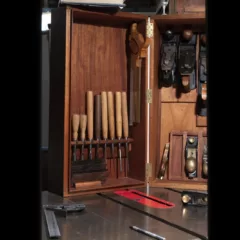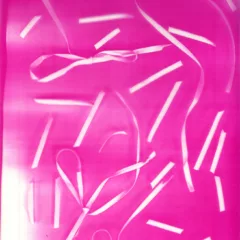You have a few days left to get to Isolated Fictions, an evocative exhibit at FLUXspace of work related to the publication of The North Georgia Gazette, a beautiful reprint of an 1821 shipboard journal, by Chicago’s Green Lantern Press.
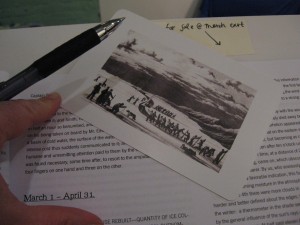
Green Lantern Press is the artist-run organization that also publishes the Phonebook, a national directory of artist-run spaces. (The most recent edition, 2008-2009, Philly’s artist-run spaces are severely underrepresented, but then even we can’t keep up.) And of course this show is at an artist-run collective space. There’s a theme here.
The story behind the book goes back to when a British fleet of exploration ships got stuck in the Arctic ice while searching for the Northwest Passage. Trapped for eight months, waiting for the ice to melt, they published a ship’s journal, The North Georgia Gazette, on orders from the fleet’s Captain Parry to keep spirits lifted. No whining allowed.
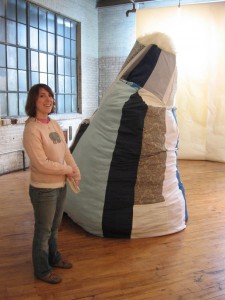
The original publication included letters to the editor, recipes, poems and reviews of on-board performances. The Gazette’s contents are reprinted here in their entirety, and embellished with an essay by contemporary Arctic explorer John Huston, as well as contemporary art work.
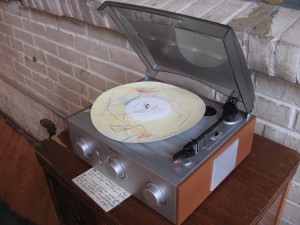
The exhibit, curated by Green Lantern Gallery & Press founding director Caroline Picard, includes fewer than a dozen pieces, which are touring the country to publicize the release of the book. Most of the art included in the exhibit is included in the book, including a limited edition 7″ record–a wood glue on paper print of a vinyl record. It can actually be played, the music of the original distorted by the wobbly backing and the iffy process. The resulting pops and squeaks and musical swoops, if you’re feeling imaginative, are quite evocative. You can hear and see this work, by Nick Butcher, on a small record player in the exhibit. The book, a small edition of 250 with silk-screened covers, is available at Flux for $30, an amazing deal!
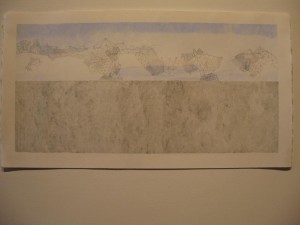
Other works include a marvelous, delicate seascape by Carmen Price that captures the white-out isolation of 24-hour Arctic days. A hilarious map of the arctic north, part fiction part real, by Rebecca Grady, and a wonderful soft-sculpture iceberg made of patchwork fabric with a fuzzy toupee of fake fur on top. Grady’s other piece, three draped rolls of somewhat crinkled paper in front of the windows has a makeshift, thin feel, making it the only piece in the show that is less than satisfying.
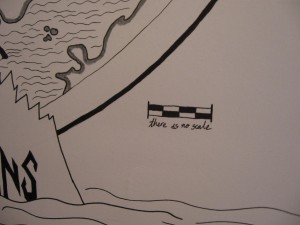
Also in the exhibit are artists Jason Dunda, Devin King and Deb Sokolow. I have images of their work–all pretty interesting–up at my Flickr site.
The show, one of the Philagrafika independent projects, is a lovely evocation of the past and the sense of awe that the sailors must have felt isolated in that barren landscape with no promise of escape.
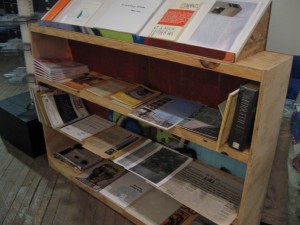
I went to the exhibit with Andrea, and while we were there we visited Flux’s temporary reading room, erected in conjunction with Isolated Fictions. It is part of Flux’s new project–an archive of Philadelphia-related art-ifacts. At this point, the reading room has a small collection that includes zines from Machete to old New Art Examiners to various Philadelphia exhibition postcards and printed materials. But, as in everything they do, Flux is ambitious and wants more.
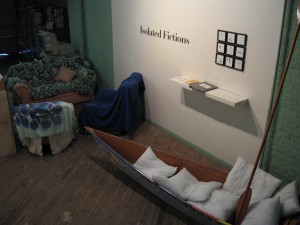
So help yourself out by helping Flux out. If you have exhibition catalogs, postcards and zines from shows in the city, old copies of Eye Level, this would be a good place to send a couple of copies. This project to preserve and make accessible contemporary Philadelphia art history parallels the Vox book on collectives, by Richard Torchia, and if I were to guess, it may have been inspired by the talk Torchia gave about the necessity of documenting. This is a breakthrough, with Philadelphia taking itself and its art history seriously!
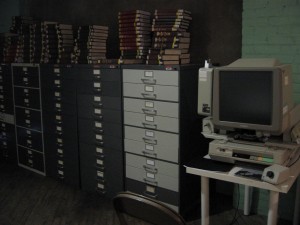
There’s one more great feature at the reading room–microfilm of the New York Times, from 1886 to 2008, and a microfilm reader and printer, that Montgomery County Community College gave up when it switched to digital versions. The advantage of microfilm is that the articles are on their pages, with the ads and everything. And they won’t become inaccessible and unusable when the digital programs go through their annual sweeping changes. So, artists, as material-oriented people who are contrarians, seem to me to be saving our culture.



